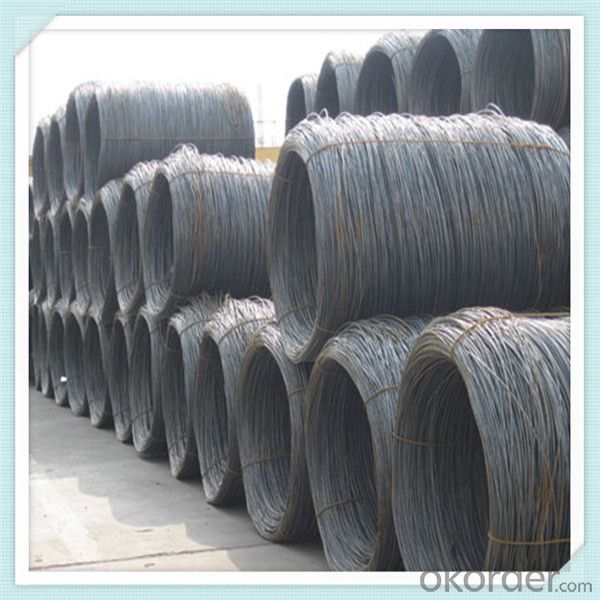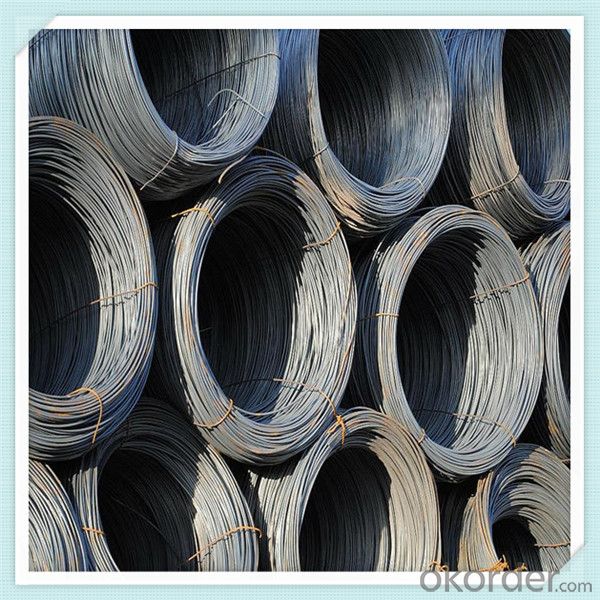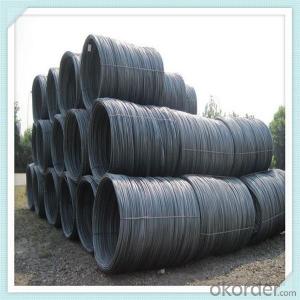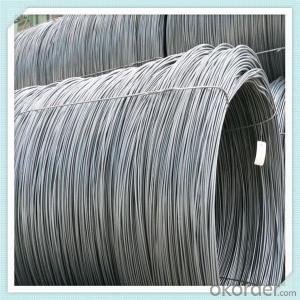Steel sea1008 wire rod coil hot rolled from China
- Loading Port:
- Tianjin
- Payment Terms:
- TT OR LC
- Min Order Qty:
- 100 m.t.
- Supply Capability:
- 142532 m.t./month
OKorder Service Pledge
OKorder Financial Service
You Might Also Like
Item specifice
Features
1、Pure steel quality, stable chemical contents, small tolerance.
2、Constant Quality, good drawing performance.
3、High dimension accuracy degree, accuracy degree of Level C up to 80%, smooth surface, less scale,
easy to be pickled.
4、Automatic bundling with 4 lines by Machine in tidy and good looks
5、Big high quality percentage, small coil percentage, and heavy coil weight for Hard Coil.
6、High sorbitizing percentage.
Used to make steel nail, mechanical spare parts. The high carbon steel wire coil is used to make steel
wire rope for different usage, spring steel wire, steel core Al strands, galvanized steel wire, galvanized steel
strands, prestressing steel wire
Product Description :
Standard | AISI, ASTM, BS, DIN, GB, JIS |
Material/steel grade | Q195-Q235,SAE1006B,SAE1006CR, SAE1008B, SAE1008CR, SAE1010B, SAE1018B, or according to customers requirements |
Wire Gauge | 5.5-12mm |
Coil weight | 1.8-2.1mts |
MOQ | 25MT |
Delivery Time | 15-30 days after receipt of L/C or deposit by T/T |
Packing | In coil and load in container, if large quantity, by bulk vessel; Can be packed as customers' special requirements |
Payment terms | 1).100% irrevocable L/C at sight. 2).30% T/T prepaid and the balance against the copy of B/L. 3).30% T/T prepaid and the balance against L/C |
Application | widely used in machinery parts, manufacturing industry, electronics industry, metal tools and others |



Application :
It generally used in braiding the hose for bathing product and machinery. With it
good flexibility, resistant to high temperature and resistant to corrosion, it
used widely in many industries.
Packing :
Hot-rolled wire rod is held in a unit with at least four steel straps in the
transverse direction and transported and stored without further packaging.
Before
the steel strapping is applied, the wire rod must be sufficiently compressed.
The strapping is fixed in the transverse direction with a single circumferential
strap so that the strapping does not slip and cause the coil to come apart.


Our service:
(1) We cooperate with famous factories with advanced equipment and well trained workers.
(2) We can provide factory price with trading company service.
(3) We continuously work on the improvement of our processes, guaranteeing
consistently high standards of quality to keep none compensation.
(4) We guarantee 24 hours response and 48 hours solution providing service.
(5) We accept small order quantity before formal cooperation.
(6) We deliver the agreed quality at the agreed time, reacting to changes in
customer wishes in a flexible way.
(7) Due to our volume and selling power, we have excellent freight rates with
shipping lines.
(8) We strive to always be fair and honest in our dealings with customers.
(9) We strive to work together with customers to achieve much more than we can
achieve alone.
(10) Through our passion and commitment we aim to be a market leader in all our
key markets. To maintain our position as market leader we must continue to add
value in all that we do.
FAQ:
1.Q: What's your MOQ(minimum order quantity)?
A: One full container, mixed acceptable .
2. Q: What's your packing methods?
A: Packed in bundle or bulk ..
3. Q: How can I buy CNBM products in my country?
A:Please send us an inquiry or email ,we will reply to you if there is distributor in your country
4. Q: Can we visit your factory?
A: Warmly welcome. Once we have your schedule, we will arrange the
professional sales team to follow up your case.
5. Q: How long does it take to get the product if i place an order?
A:With the process of your requirements,we will pack and deliver in 3
-7 days. If it is by sea shipment,it will take 15-45 days depending on different locations
- Q:How is steel wire rod used in the manufacturing of wire for suspension cables?
- Steel wire rod is a crucial component in the manufacturing of wire for suspension cables as it serves as the primary raw material. The steel wire rod is first drawn through a series of dies to reduce its diameter and increase its strength. This process, known as wire drawing, helps create the desired thickness and tensile strength required for suspension cables. The drawn wire is then further processed, usually through stranding or twisting, to form multiple strands, which are then combined to create the final suspension cable. The high strength and durability of steel wire rod make it an ideal material for suspension cables, ensuring the cables can safely support heavy loads and withstand the environmental stresses they will encounter.
- Q:What are the standard bending requirements for steel wire rod?
- The standard bending requirements for steel wire rod typically depend on the specific industry or application in which the wire rod is being used. However, there are certain general guidelines and specifications that are commonly followed. One of the key factors in determining the bending requirements is the diameter or gauge of the steel wire rod. Thicker wire rods generally require a larger bending radius compared to thinner ones. This is to ensure that the wire rod does not undergo excessive strain or deformation during the bending process. Another important consideration is the type of steel used in the wire rod. Different types of steel have varying levels of ductility and tensile strength, which can impact the bending requirements. It is crucial to adhere to the manufacturer's specifications and guidelines to ensure the wire rod is not subjected to excessive stress or damage during bending. In addition to these factors, industry standards and regulations may also dictate specific bending requirements for steel wire rods. For example, the American Society for Testing and Materials (ASTM) has established standards such as ASTM A510 which provides guidelines for the carbon steel wire rod used in various applications. Ultimately, the standard bending requirements for steel wire rod will depend on factors such as the diameter, type of steel, and industry standards. It is essential to consult relevant specifications and guidelines to ensure proper bending procedures are followed, thus maintaining the integrity and functionality of the wire rod.
- Q:How is the chemical composition of steel wire rod analyzed?
- The chemical composition of steel wire rod is typically analyzed using various laboratory techniques such as spectroscopy, X-ray fluorescence (XRF), and optical emission spectroscopy (OES). These methods involve exposing the wire rod to high energy sources or chemical reactions to determine the presence and concentration of different elements in the steel. By analyzing the chemical composition, manufacturers can ensure that the steel wire rod meets the required standards and specifications for its intended applications.
- Q:How is the cleanliness of steel wire rod assessed?
- Various methods and techniques are utilized to evaluate the cleanliness of steel wire rod, ensuring adherence to high-quality standards. One primary approach involves visual inspection, whereby well-trained personnel meticulously examine the wire rod's surface for visible defects such as scale, cracks, pits, or any other surface irregularities that may compromise its cleanliness. Another technique employed is magnetic particle testing, wherein the wire rod is placed within a magnetic field, and magnetic particles are applied to its surface. Any discontinuities or flaws in the material will attract and accumulate these particles, rendering them discernible under suitable lighting conditions. The assessment of steel wire rod cleanliness also involves the utilization of ultrasonic testing. This non-destructive testing method employs high-frequency sound waves to detect internal defects such as inclusions, voids, or other imperfections that may not be visually evident. Ultrasonic waves are propagated through the wire rod, and any alterations or reflections in the wave patterns can indicate the presence of defects. Chemical analysis represents another pivotal aspect of cleanliness assessment. Samples of the wire rod are extracted and subjected to chemical tests to determine their composition and impurity levels. This analysis enables the identification of contaminants like sulfur, phosphorus, or other elements that could impact the steel's cleanliness. In summary, a combination of visual inspection, magnetic particle testing, ultrasonic testing, and chemical analysis is typically employed to assess the cleanliness of steel wire rod. By implementing these methodologies, manufacturers can guarantee that the wire rod meets the requisite cleanliness standards, thereby ensuring its suitability for diverse applications.
- Q:How is steel wire rod used in the manufacturing of wire for overhead power lines?
- Steel wire rod is used in the manufacturing of wire for overhead power lines by being drawn through a series of dies to reduce its diameter. This process, known as wire drawing, helps to increase the wire's strength and flexibility. The resulting steel wire is then stranded or twisted together to form a conductor that can efficiently transmit electricity over long distances. Additionally, the steel wire's corrosion resistance and high tensile strength make it ideal for withstanding the environmental challenges and mechanical stresses associated with overhead power lines.
- Q:How is steel wire rod used in the manufacturing of tire cords?
- Steel wire rod is an essential component in the manufacturing of tire cords due to its strength, durability, and flexibility. Tire cords are the reinforcing materials embedded within the rubber of a tire, which provide strength and stability to the tire structure. To create tire cords, steel wire rod is first drawn through a series of dies to reduce its diameter and increase its tensile strength. This process, known as wire drawing, ensures that the wire rod meets the specific requirements for tire cord manufacturing. Once the wire rod has been drawn to the desired thickness, it is further processed by a metal coating process. This involves applying a layer of brass or zinc to the wire surface to enhance its adhesion to rubber. The metal coating also protects the wire from corrosion and improves its fatigue resistance, ensuring the longevity and performance of the tire cord. The coated wire rod is then twisted into strands, typically in a helical pattern, to form tire cord yarns. These yarns are then embedded within the rubber matrix during the tire manufacturing process, providing reinforcement and enhancing the tire's structural integrity. The steel wire rod used in the manufacturing of tire cords plays a crucial role in enhancing the strength and durability of the tire. The high tensile strength of steel wire rod allows the tire cords to withstand the immense forces and loads experienced by tires during operation, including acceleration, braking, and cornering. The flexibility of the wire rod also enables the tire cords to conform to the shape of the tire and absorb shocks, contributing to a smoother ride and improved overall performance. In summary, steel wire rod is a vital component in the production of tire cords. Its strength, durability, and flexibility make it an ideal material for reinforcing tires, ensuring their safety and long-lasting performance on the road.
- Q:What are the different types of steel wire rod coatings used for electrical conductivity?
- The different types of steel wire rod coatings used for electrical conductivity include copper coating, zinc coating, tin coating, and silver coating.
- Q:How is steel wire rod used in the manufacturing of wire mesh for concrete reinforcement?
- The production of wire mesh for concrete reinforcement relies heavily on steel wire rod. Wire mesh, which consists of interconnected steel wires in a grid-like structure, is responsible for improving the strength and durability of concrete structures. To create the wires needed for the mesh, steel wire rod is used as the main material. Typically made from carbon steel, the rod undergoes several processes to achieve the desired wire diameter and tensile strength. These processes involve hot rolling, pickling, and drawing. Once the steel wire rod has been transformed into wire, it is then shaped into a mesh pattern through either weaving or welding. The mesh pattern can vary and commonly includes square or rectangular openings. The spacing between the wires is determined based on the specific requirements of the concrete project. Throughout the manufacturing process, the wire mesh is designed with great care to reinforce concrete structures. When concrete is poured, the wire mesh is placed within it, forming a network of interconnected wires that evenly distribute the load. This reinforcement greatly enhances the concrete's ability to withstand stress, such as heavy loads or temperature changes, and reduces the likelihood of cracking or breaking. Furthermore, wire mesh also helps control shrinkage and prevents the formation of large cracks in the concrete. By limiting the movement of individual concrete elements, the mesh ensures that any cracks that do occur are smaller and easier to manage. In conclusion, steel wire rod plays a critical role in the production of wire mesh for concrete reinforcement. It is transformed into wire and then shaped into a mesh pattern through weaving or welding. This mesh is then incorporated into concrete structures to enhance their strength, durability, and resistance to cracking and breaking.
- Q:What are the main factors affecting the wear resistance of steel wire rod?
- The main factors affecting the wear resistance of steel wire rod include the composition of the steel, the microstructure, the hardness, the surface finish, and the lubrication or lack thereof during use.
- Q:How are steel wire rods used in the production of piano wire?
- Steel wire rods are used in the production of piano wire by being drawn through a series of dies to gradually reduce their diameter. This process, known as wire drawing, results in a long, thin, and high-tensile strength wire that is then coiled, hardened, and tempered to create the strong and resilient piano wire used in piano strings.
1. Manufacturer Overview |
|
|---|---|
| Location | |
| Year Established | |
| Annual Output Value | |
| Main Markets | |
| Company Certifications | |
2. Manufacturer Certificates |
|
|---|---|
| a) Certification Name | |
| Range | |
| Reference | |
| Validity Period | |
3. Manufacturer Capability |
|
|---|---|
| a)Trade Capacity | |
| Nearest Port | |
| Export Percentage | |
| No.of Employees in Trade Department | |
| Language Spoken: | |
| b)Factory Information | |
| Factory Size: | |
| No. of Production Lines | |
| Contract Manufacturing | |
| Product Price Range | |
Send your message to us
Steel sea1008 wire rod coil hot rolled from China
- Loading Port:
- Tianjin
- Payment Terms:
- TT OR LC
- Min Order Qty:
- 100 m.t.
- Supply Capability:
- 142532 m.t./month
OKorder Service Pledge
OKorder Financial Service
Similar products
New products
Hot products
Hot Searches
Related keywords


























